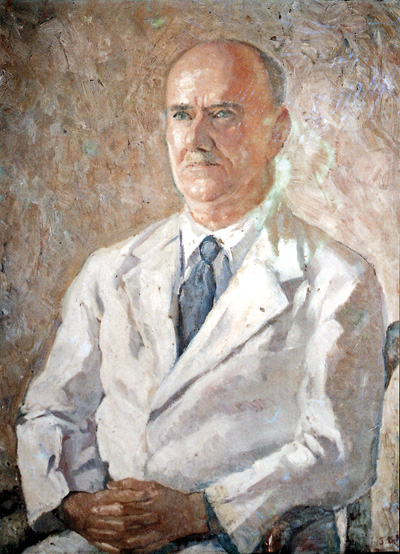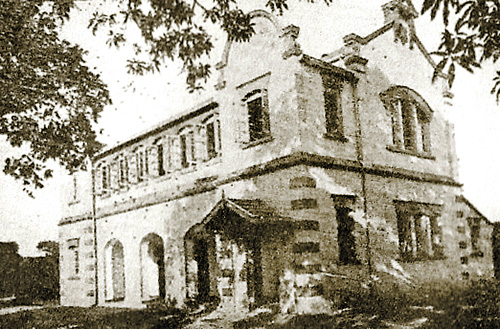Sunday Times 2
The bacteriologist who battled diseases and famine in colonial Ceylon
Between the two World Wars, Sri Lanka was ravaged by diseases and famine. Malaria had wiped out a vast slice of the rural population. Cholera and smallpox were a permanent threat in the ghettoes and slums of the urban centres — often introduced by migrant labour from neighbouring South India. Yaws was rampant in the rural areas.

An oil portrait by J.D.A. Perera painted circa 1930s.
Several important networks of irrigation tanks and canals lay derelict and rice was imported. The takeover of lands by the Wasteland Ordinance had rendered many of the peasant class landless.
The recession, caused by the economic downturn made access to a sustainable nutritious diet well beyond the purse of the poor. Medical services were readily available only to the middle and upper classes of the capital city, Colombo, and a few provincial towns.
But overcoming these obstacles and setbacks, a handful of medical men addressed the overriding issues of treating the poor and the needy. By the end of 1915, with the First World War in progress, a medical man, trained in Pathology at the Seamen’s Hospital in Greenwich, London and Bacteriology at the Postgraduate School of Clinical Medicine arrived in Colombo to take up the post of Director of the Bacteriological Institute, now renamed the Medical Research Institute (MRI), founded in 1900. He was Dr Lucius Nicholls LSA (London), MD. B.C., B.A (Cantab), and he had previously served in St. Lucia’s, British West Indies and Kenya.
A decade before he arrived, the country’s civil medical staff consisted of one Principal Officer, 140 medical officers, 247 apothecaries, 152 nurses, 114 vaccinators and 48 others. They were administering 65 hospitals, 424 Government dispensaries and 142 estate dispensaries. In 1905, as many as 1,850,000 patients had passed through the hospital system and 2,497 surgical operations had been performed with 88 deaths.
In addition to these institutions, there was the Lunatic Asylum in Jawatha, a Leper Hospital, the De Soysa Lying in Home and the Lady Havelock Hospital for Women and Children. The Colombo Medical College, established in 1870, produced the doctors to man the hospitals. In the first decade of the 20th century, an Eye Hospital and a clinic to research the effects of Tropical Diseases were founded, in addition to the Bacteriological Institute. To oversee vaccination, a Pasteur Institute was added to the health system in 1917.
These rather inadequate medical facilities serviced a population of almost 2.5 million citizens largely scattered in remote villages and towns.
Many of these areas could only be accessed by a skeletal network of roads and railways linking Colombo with the exception of the main urban centres of Kandy, and Galle.
Dr Lucius Nicholls served Sri Lanka for 30 years, between 1915 and 1945, as director of the Bacteriological Institute, superintendent of the Pasteur Institute and as lecturer in Tropical Medicine and Bacteriology at the Ceylon Medical College. Over a short period, he held the post of Acting Medical Superintendent of the Lunatic Asylum and Acting Government Entomologist.
He was a prolific researcher and his articles on a wide range of subjects were published in a variety of journals. His interests ranged from bacterial and parasitic infections to birds, snakes, reptiles and insects, but his forte was nutrition. He was the first Associate Editor of Section D: Medical Sciences of the Ceylon Journal of Science between 1924 and 1941. His seminal works in medicine included the first report of Melioidosis in Sri Lanka, and some vital papers on Vitamin A deficiency. His major work in herpetology was ‘A guide to the identification of land snakes of Ceylon.’ [1929]
He published three books on nutrition. One, “Tropical Nutrition and Dietetics” [1938] served as a primer in the subject over four editions. He inspired future generations of researchers, especially Professor T.W. Wikramanayake who expanded on this work and went on to publish many authoritative textbooks on nutrition.

The Bacteriological Institute, 110 years ago.[Twentieth Century Impressions 1908
Role in other social and sporting activities
Nicholls was active in many fields. Like several of the Sri Lanka-based British medical professionals such as Wall, Smith and Osmund Hill, he was an obsessive collector and observer of birds, snakes and mammals. During his work on the identification of land snakes, he described a new endemic species of earth snake, which he named Silybura phillipsi (now Rhinophis phillipsi), in acknowledgement of the contribution of W.W.A. Phillips, the renowned naturalist. Many years later, he described a new gecko from the Malay Peninsula, and, for this and other contributions, he was elected a Fellow of the Zoological Society.
As a keen observer of bird life, he listed 71 species of birds at his residence at McCarthy Road (Wijerama Mawatha), Colombo in a fascinating, informative article, The Birds of a Colombo Garden, [Loris Nov.1936]published in the first issue of the Loris, the journal of the Ceylon Game and Fauna Protection Society [now the Wildlife and Nature Protection Society]. His list includes several species of birds which were common in the twentieth century in the city including the Common Indian Night Jar, Pied Cuckoo, White Browed Bulbul and Common Iora, birds which are no longer extant in the Colombo city reflecting the deteriorating ecological environment.
In 1930, he was elected as the President of the Society for his contribution to wildlife, and again in 1938. He was for many years an active member of the Executive Committee and oversaw the Government declared Wilpattu Reserve of which he was the honorary Warden. He served on the C.V. Brayne-headed Fauna and Flora Protection Committee, which led to the promulgation of the Fauna and Flora Protection Act. In an article titled, A symposium on Ticks [Loris June 1945], he advises those doing fieldwork in the forests and scrub jungles how to treat tick bites.
He was a keen supporter of the newly established Zoological Gardens at the grounds of the National Museum and was later translocated to Dehiwela. He advised the Zoological Gardens staff on the best nutrition to be offered to the larger mammals in their care, and published his observations in the Loris -Notes on the Feeding and care of Animals.[Loris Dec.1938].
A keen sportsman, Lucius was involved in cricket, golf and the Turf Club. He was the Captain of the Royal Colombo Golf Club in 1939/40 and President in 1944 and the winner of the Clifford Cup in 1928. Nicholls served as a Captain, East African Medical Services in British East Africa and as a Lieutenant in the Ceylon Medical Corps in the First World War and is listed in the Ceylon Roll of Honour for World War 1.
He was actively involved in the activities of the colony serving as a Committee Member of the Ceylon Turf Club, the Ceylon Natural History Society, Civil Medical Association, Medical Department Sports Club and the Zoological Gardens Advisory and Standing Committees. He served in the committee studying the Prevalence of Parangi (yaws) in Sri Lanka and was the Hon. Secretary to the Ceylon Council for Venereal Disease.
After leaving Sri Lanka, he served as Acting Director of the Far East Bureau of the World Health Organisation in Singapore before finally retiring to Britain where he continued to comment on tropical diseases and nutrition in many letters to the Editor of the Lancet.
Surly he was a Man for All Seasons.
* Ismeth Raheem, Chartered Architect [ismethraheem@gmail.com] and Enoka Corea, Senior Lecturer, Microbiology Faculty of Medicine, University of Colombo [enokacorea@hotmail.com].

